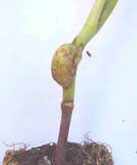White blister on broccoli
White blister is a plant disease that affects brassica crops and is caused by the fungus-like organism Albugo candida.
There's no risk to consumers, as the fungus only affects the growth and appearance of brassica plants.
Symptoms of white blister
The following symptoms can indicate white blister:
- blisters on the underside of leaves that consist of masses of white dust-like spores (figure 1)
- distortions of flowers and leaves (figure 1)
- swellings on roots and stems (figure 2)
- yellow to brown spots on the upper leaf surface (figure 3) which have white dust-like spores on the corresponding under leaf surface.



Host range
The disease is confined to crucifers.
Conditions for infection
The fungus prefers the following conditions:
- free water (dew, fog or rain) on leaves and stems
- temperatures of 1°C to 20°C for spores to germinate
- temperatures ranging from 10°C to 25°C for the disease to develop
The best conditions for spores to infect plants are 3 hours of leaf wetness at 20°C.
Blisters take 6 to 10 days to form after infection.
Source and spread of disease
The source of disease is usually:
- diseased plants, crops or seed
- volunteer crucifers
- wild crucifers and crucifer weeds
- debris
The disease most often spreads to other places through spores in the air or soil. For example:
- wind, rain or insects spread aerial spores
- rain splash can spread spores from soil and from plant to plant
Controlling white blister
Control white blister with a combination of the following management practices.
Controlled watering
Spores need water to germinate and wet leaf surfaces to infect plants. A short, heavy watering is preferable to a long, light watering.
If possible, avoid night irrigation.
Ventilation
Maintain good air-movement in the environment to dry leaves off quickly and reduce infection. This may mean running rows in the direction of the wind and increasing plant spacing.
Nutrition
Maintain a balanced program of nutrition.
Applications of phosphorous (P) and potassium (K) fertilisers have been shown to reduce the susceptibility of radish to white blister.
Hygiene
Remove sources of spores, such as:
- volunteer radish
- crucifer weeds
- crop debris (if possible)
Use an approved fungicide
Chemical control is often one of the methods available for plant diseases as part of an integrated disease management program. For information on currently registered chemicals, check the Australian Pesticide and Veterinary Medicine Authority (APVMA) website.
Always consult the label to determine the directions for use and read the Safety Data Sheet before using any chemical product.
More information is available from:
- plant retail nurseries
- cropping consultants
- chemical resellers
- the fungicide manufacturer
These chemicals are available in various pack sizes. Unless necessary, avoid choosing large pack sizes so you don't have to store leftover chemicals.
In severely infected areas, susceptible host plants should be removed, since re-infection after fungicide application is highly likely.
Life cycle of white blister on broccoli
Usually the life cycle of white blister is as follows:
- Sexual spores (oospores) form in galls and in swollen leaves and flowers, especially when downy mildew is present. These may become crop debris and incorporated into the soil. They germinate to produce zoospores that swim or are splashed onto hosts.
- These zoospores settle on leaves, germinate and infect plants by entering through stomata.
- Blisters (pustules) take 10 to 14 days to form after infection. These blisters contain vegetative spores (sporangia), which rupture through the leaf surface.
- Wind, rain and insects spread these spores (sporangia) to other places within the crop during the growing season. In the presence of water, they germinate to produce zoospores, which swim and enter stomata and form more blisters.
Reporting an unusual plant insect pest or disease
Report any unusual plant pest or disease immediately using our online reporting form or by calling the Exotic Plant Pest Hotline on 1800 084 881. Early reporting increases the chance of effective control and eradication.
Please take multiple good quality photos of the pests or damage to include in your report where possible, as this is essential for rapid pest and disease diagnosis and response.
Your report will be responded to by an experienced staff member, who may seek more information about the detection and explain next steps.
Report online